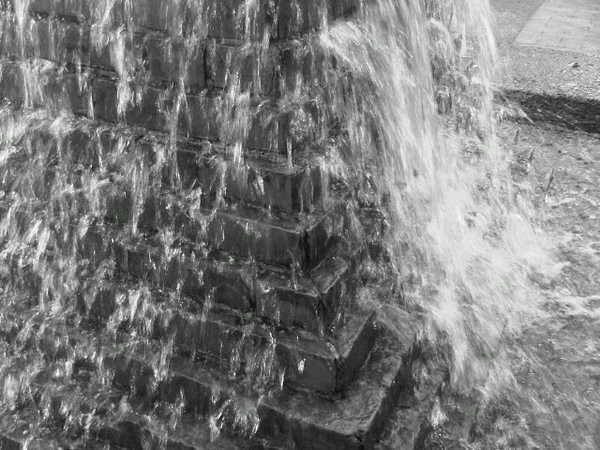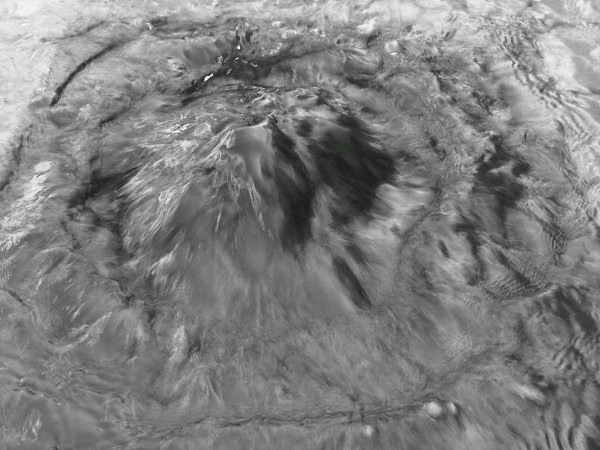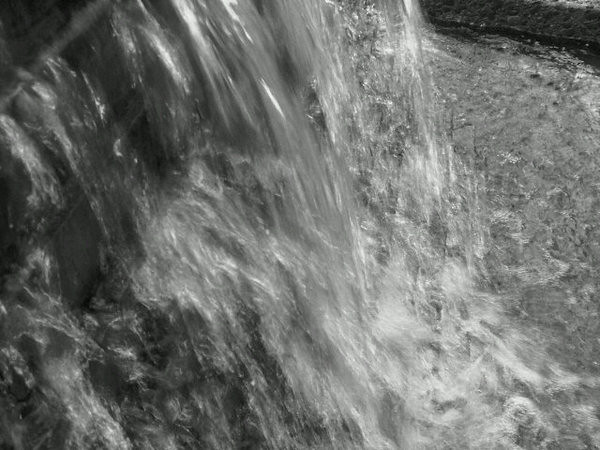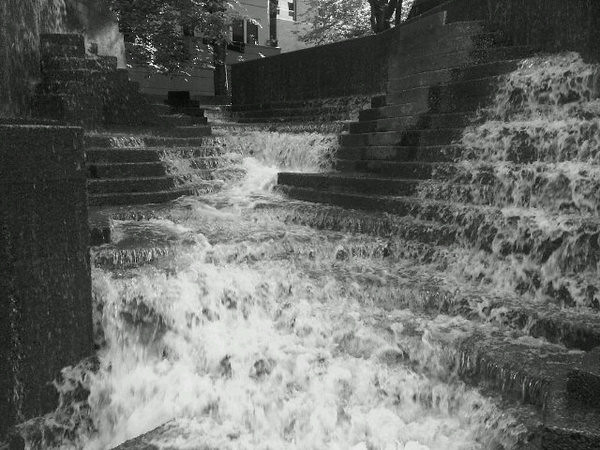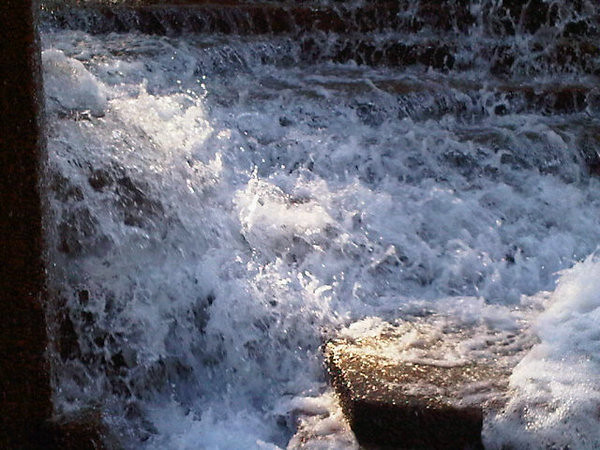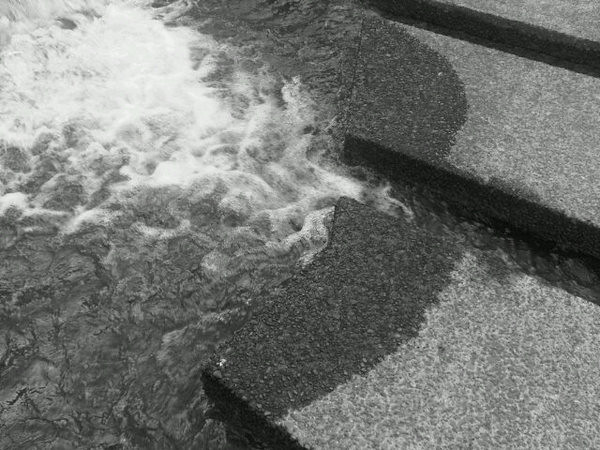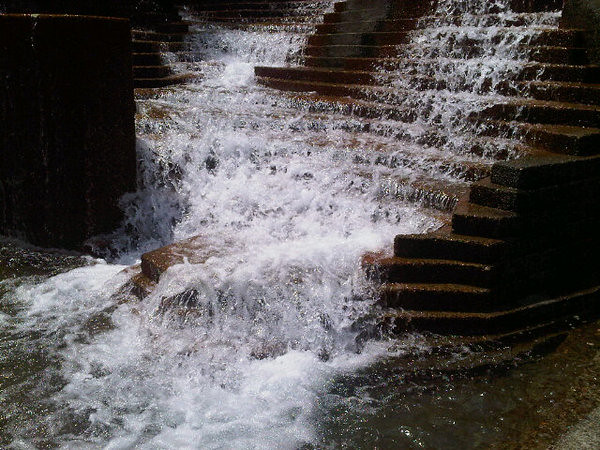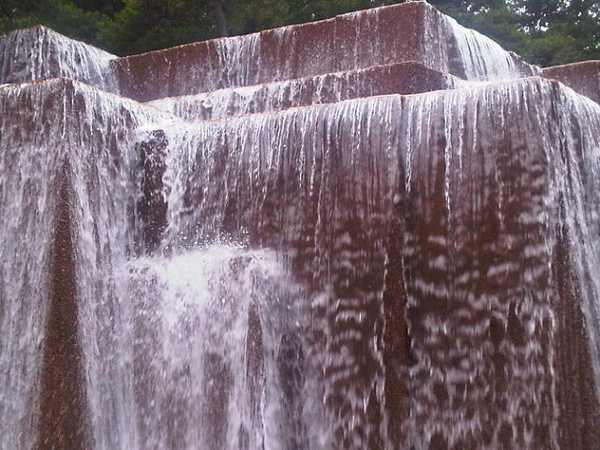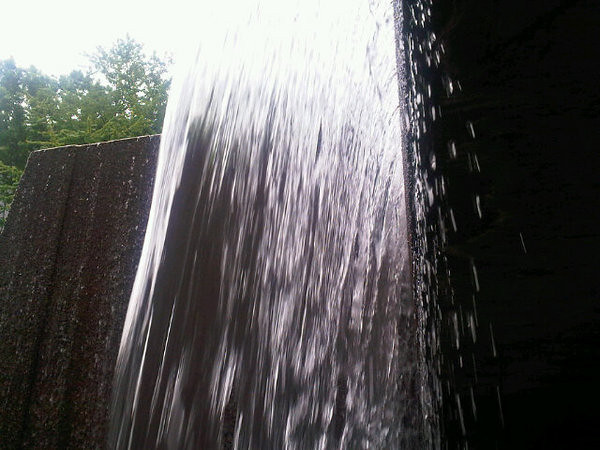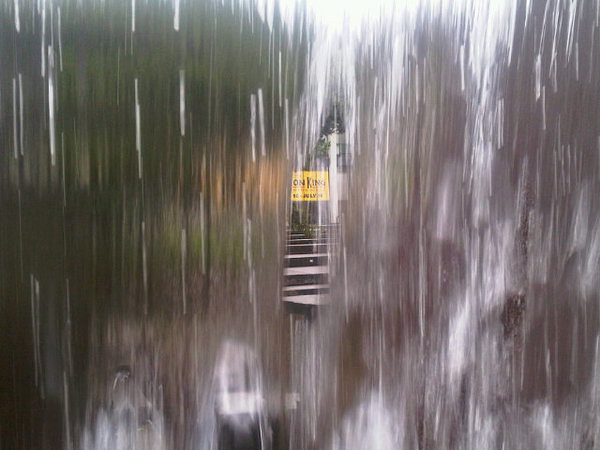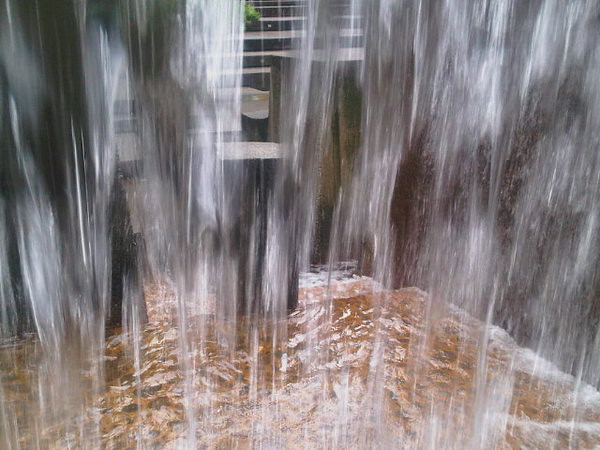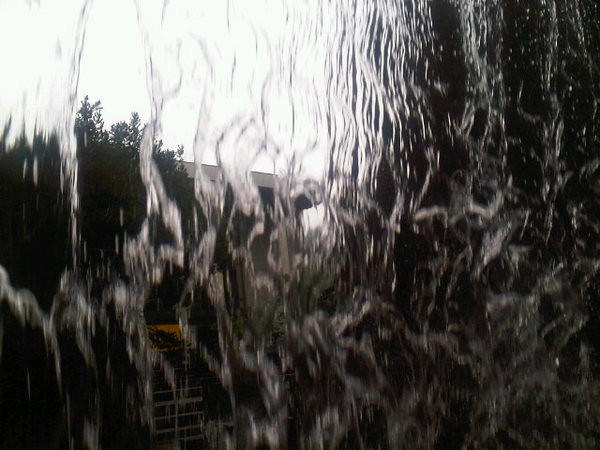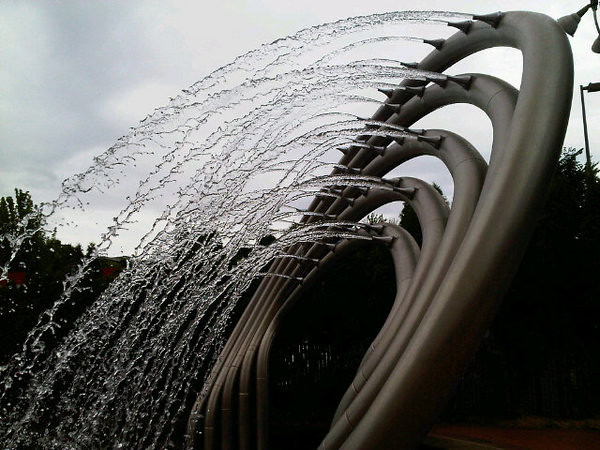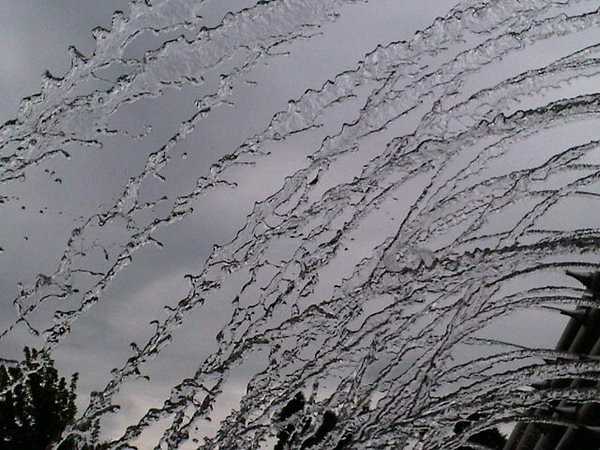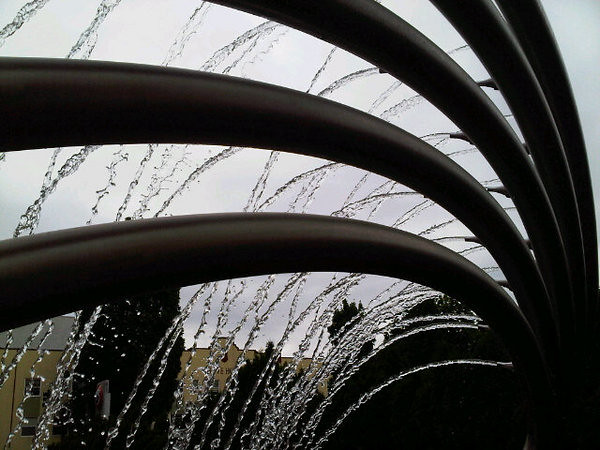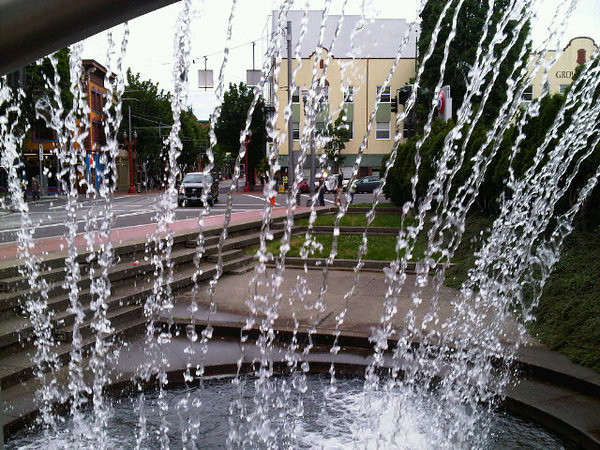As a general rule of thumb, Portland's public art buyers don't usually go for conceptual stuff. Abstract stainless steel whatzits are still the safe choice here, made by the same usual suspects who've been making them since the 70s, and who will happily cobble together yet another one whenever a new public works project needs to burn its one percent for art. Our subject today is one of the few rare exceptions to the rule of thumb, one which made a quick cameo here in a post back in 2006:
... I've finally figured out something that's been puzzling me for months now. At several spots along the streetcar line, and at other locations in the Pearl, there are these motion-sensored spotlights with solar panels attached, aimed at the sidewalk. Sometimes they trigger and click on when you walk by, which can be a little surprising. There's one on SW 10th around Stark or Alder or Washington that clicks on and illuminates a manhole cover in the sidewalk. The first time I saw this it startled me. I thought it must be some sort of inexplicable homeland security measure or utility maintenance aid or something. Turns out the spotlights are part of an art installation titled More Everyday Sunshine, by Harrell Fletcher. It all makes sense now. I had a feeling it might be art, but it isn't labelled anywhere, and the equipment for each light is quite utilitarian, so it was hard to be sure.
I like the fact that the spotlights come with no signs or explanations attached, adding a touch of mystery to ordinary downtown streets. Knowing their purpose is like belonging to a secret society, without all the funny handshakes and world domination. The Tribune dug into this mystery in a 2007 Stumptown Stumper, which included a brief interview with their creator. The lights have also gotten a five-star Yelp review, oddly enough, which is possibly the Internet's only source of art criticism even less authoritative than the humble blog you're reading now. Elsewhere in the blogosphere (a word I haven't used in years, to be honest -- is there still a blogosphere?), More Everyday Sunshine is the nightcap on someone's tour of interesting Portland attractions and it gets a mention in a post at The Hallucinogenic Toreador that also covers murals from China's Cultural Revolution and a few of the author's ideas for future art projects.
This post took a while to create. At first I only had some daytime photos of the solar panels and lighting gear, which aren't very photogenic, and I had no pictures of it actually in operation. I felt this post couldn't go live with just the daytime photos, since I wasn't really capturing the essence of the thing that way, and I take that seriously for some reason. It's not that I wasn't trying to get proper nighttime photos, mind you. I wandered around a couple of times trying to get various spotlights to trigger, hopefully without arousing suspicion and getting tasered by Officer Friendly, or having to explain this quixotic internet quest to random Midwestern tourists who want to meet a real live Weird Portlander. I finally got a couple of spotlights to light up this evening, and I got a few photos, so this post could finally move forward. One photo shows an illuminated shrub outside an apartment building at 11th & Columbia, while another shows a pool of light on the sidewalk at 5th & Mill. Neither one is really all that spectacular, but I think they get the general idea across. I tried a few other spotlights but they wouldn't come on for me. So either some of the lights are out of order, or I just haven't figured out the secret trick to making them light up on command. The fact that a couple of them came on suggests that I'm probably not a vampire. So that's encouraging, at least; with my luck I'd end up as the sparkly sort of vampire, which would be embarrassing.
The RACC page for More Everyday Sunshine includes a detailed artist's statement:
As a kid I would go for walks with my father and he would point things out to me. He seemed interested in everything—an architectural detail, an old tree, a geological formation, a historical monument, an unusual shop or restaurant. Features otherwise hidden to me would be revealed and made significant while spending time with him.
Over the past eight years I have worked on projects exploring the dynamics of social spaces, communities, and environments. These projects have taken the form of installations, publications, educational activities, and public art pieces and have involved a variety of populations: middle school students in Oakland, office workers from the City of Richmond, local residents from the Sunset District in San Francisco, students living in dorms at the University of Washington, shoppers at a mall in Pleasanton, urban gardeners in the Mission District of San Francisco, among others.
My project for the Streetcar Alignment brings together my early memories of walks with my father, photography, and my involvement with community based art projects. To do this I will install a series of solar powered lights on motion sensors to literally highlight aspects of the neighborhoods that the streetcar will be running through. The units would be attached to pre-existing street car poles and operate from dusk to late evening. It’s evident that these neighborhoods already have cultural and aesthetic qualities that define them.
The idea draws strictly on what the various neighborhoods along the alignment already have—unusual architecture, old signs, specific trees, old fire hydrants and infrastructure, etc. I will choose several locations to just light a circular spot on the sidewalk that a person could walk into and for a moment stand out for their own visual or gestural significance. In a way, the lights would act as real time photographs of interesting aspects in Portland’s nighttime urban environment.
If you want to track down the spotlights yourself and see if you have better luck triggering them than I did, I came up with a list of locations from one of the RACC public art maps. They're only along the streetcar's NS line as it existed in 2004, so there's nothing on the Eastside or along the South Waterfront extension.
- SW 5th & Mill (platform spot)
- SW 4th & Montgomery (drinking fountain)
- SW Park & Market (tree knot)
- SW 10th & Mill (bench)
- SW 11th & Columbia (flower bed)
- SW 11th & Jefferson (tree)
- SW 10th & Yamhill (library bench)
- SW 11th & Yamhill (face in molding)
- SW 10th & Washington (manhole cover)
- NW 10th & Couch (manhole in sidewalk)
- NW 10th & Hoyt (downspout)
- NW 11th & Flanders (building vent)
- NW 11th & Irving (bench)
- NW 16th & Northrup (metal in asphalt)
- NW 21st & Northrup (word on back of building)
For extra credit, see this 2003 Mercury story on Fletcher's
And Even More Everyday Sunshine, a photographic exhibit at the Multnomah County Department of Community Justice in downtown Portland. That was a decade ago, though, and it's probably long gone by now. I haven't worked up the nerve to go in and check.
